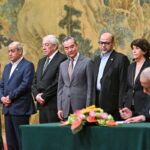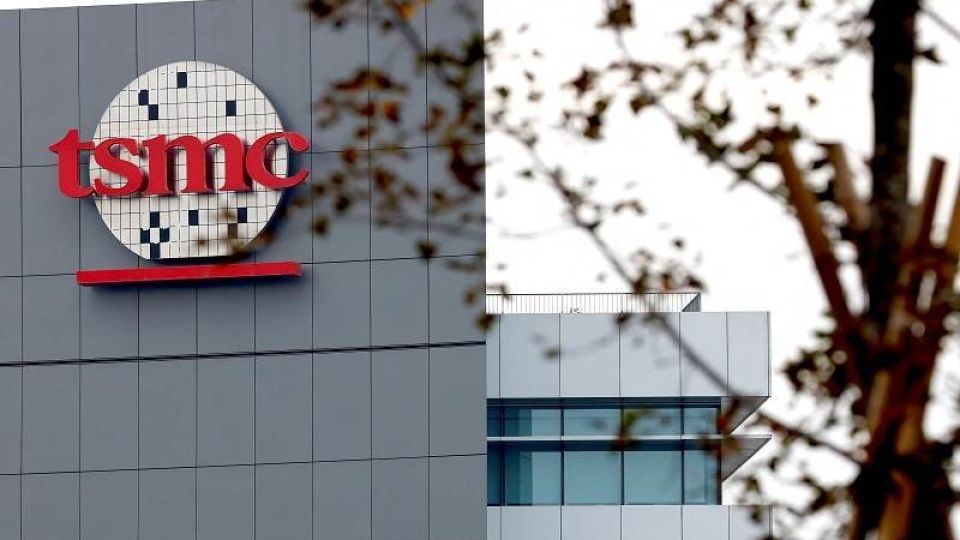The post-Cold War global structure has collapsed amid the confrontation between the United States and China, and Russia’s invasion of Ukraine. What will become of the world order long led by the United States? What strategies should Japan take in response? The following is the fifth and final installment in a series of articles examining the struggle for dominance among global powers in the economic arena.
The date was Dec. 6 last year, the place a wilderness dotted with cactuses in the southwestern U.S. state of Arizona. Here and on this day, Taiwan Semiconductor Manufacturing Co. (TSMC), the world’s largest contract chipmaker, announced that it would build a factory to produce cutting-edge semiconductors and held a ceremony to celebrate that plan.
Company founder Morris Chang was among those at the event, as was Tim Cook, CEO of Apple Inc., a major consumer of semiconductors. U.S. President Joe Biden said the factory could be a “game-changer” in the semiconductor supply chain.
TSMC’s plant will produce 3-nanometer chips — a nanometer is a billionth of a meter — the mass-production of which has not seen significant progress around the world.
“Arizona will become a new Silicon Valley,” Prof. Andy Wang of Northern Arizona University said hopefully.
The Biden administration plans to provide subsidies equivalent to trillions of yen to companies that build computer chip factories in the United States. Under the free trade system, the international community has sought coexistence and co-prosperity through the horizontal linkage of the international division of labor. However, the United States has shifted toward domestic production of semiconductors and decoupling from Chinese companies, partly due to concerns over a contigency involving Taiwan,.
Semiconductors are indispensable in both military and civilian applications, for products ranging from smartphones to missiles.
The U.S. strategy is to secure a supply chain in the Western camp, to have an advantage over China.
Symbolic of this strategy is the “Chip 4” alliance, a multilateral framework involving the United States, Japan, South Korea, and Taiwan. These nations have different areas of expertise in semiconductor-related technologies: the United States excels in design, Japan in manufacturing equipment, South Korea in memory chips, and Taiwan in arithmetic processing semiconductors. The idea is to join forces also with European companies under the U.S.-led initiative.
At an electronics store in Sanlitun, one of the busiest areas in Beijing, many advertising slogans for smartphones with high-speed connectivity can be seen, like “Get a discount by signing a 5G contract!”
But the sales push is low-key for Mate 50, the latest smartphone from China’s Huawei Technologies Co., which went on the market last September. The term 5G in nowhere in sight and a store clerk said in a low voice, “It’s compatible with 4G,” the fourth-generation mobile communication system that came before 5G.
In 2020, the U.S. government deemed Huawei to be a company that is either owned or controlled by the Chinese military, and tightened restrictions. Since September 2020, Huawei has been unable to receive supplies of 5G-compatible semiconductors manufactured by TSMC using U.S. technologies.
Huawei shipped 240 million smartphones in 2019, making it one of the top three companies in the global market. But in 2021, its market share plummeted to 3%. Huawei holds many patents related to 5G and is considered a “Gulliver-like figure,” in the words of a senior official of Japan’s Economy, Trade and Industry Ministry. However, it will not be able to do much on its own if its supply network for semiconductors, the heart of a smartphone, is constricted.
In “Made in China 2025,” a policy launched in 2015 to foster high-tech industries, the Chinese government has chosen semiconductors as one of 10 priority fields and set a goal to raise the proportion of domestically made products to 70% by 2025.
However, domestic production has been progressing at a snail’s pace, with that percentage hovering at less than 16% in 2019 and expected to be only at 20% in 2024. The administration of President Xi Jinping is greatly concerned about the country’s economic slowdown.
Japan and Germany are also poised to offer huge subsidies to entice TSMC to set up plants in their countries, to bolster their economic security. The “semiconductor divide” has been growing around the world, and globalization is entering an era of contraction.
Source : Asia News Network
















